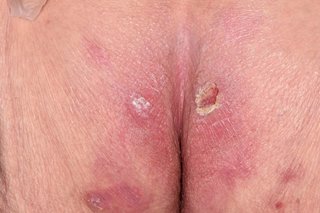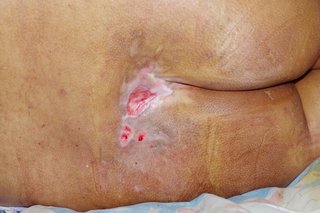Pressure ulcers (pressure sores or bed sores) are areas of damage to your skin and the tissue underneath. You have a higher chance of getting them if you have difficulty moving.
Symptoms of a pressure ulcer
Pressure ulcers usually form on bony parts of the body, such as the heels, elbows, hips and tailbone.
Symptoms of a pressure ulcer include:
- discoloured patches of skin that do not change colour when pressed – the patches are usually red on white skin, or purple or blue on black or brown skin
- a patch of skin that feels warm, spongy or hard
- pain or itchiness in the affected area of skin
The ulcers usually develop gradually, but can sometimes appear over a few hours.
They can become a blister or open wound. If left untreated, they can get worse and eventually reach deeper layers of skin or muscle and bone.


Non-urgent advice: See a GP if:
- you think you or someone you care for have a pressure ulcer
Urgent advice: Ask for an urgent GP appointment or get help from NHS 111 if:
You or someone you care for have symptoms of a pressure ulcer and:
- hot, swollen or red skin – it can look blue or purple on brown or black skin
- pus coming out of the ulcer
- a high temperature
- severe pain or pain that's getting worse
You can call 111 or get help from 111 online.
What we mean by severe pain
- Severe pain:
-
- always there and so bad it's hard to think or talk
- you cannot sleep
- it's very hard to move, get out of bed, go to the bathroom, wash or dress
- Moderate pain:
-
- always there
- makes it hard to concentrate or sleep
- you can manage to get up, wash or dress
- Mild pain:
-
- comes and goes
- is annoying but does not stop you doing daily activities
Treatments for pressure ulcers
How a pressure ulcer is treated depends on how severe it is.
Changing position and moving regularly is important to help relieve pressure on the ulcers and help stop new ones forming.
Other treatments include:
- specially designed mattresses and cushions
- dressings to protect the ulcer and help it heal
- creams and ointments
- antibiotics if the ulcer is infected
- cleaning the ulcer
If the pressure ulcer is severe or other treatments have not worked, you may need to have surgery to clean and close the ulcer.
Causes of pressure ulcers
Pressure ulcers are caused by something putting pressure on or rubbing your skin.
It can happen to anyone, but it's usually if you have problems moving, as this can mean the weight of your body is always putting pressure on the same areas of skin, which can damage it.
You have a higher chance of getting a pressure ulcer if you:
- have problems moving
- have had a pressure ulcer before
- have been seriously ill in intensive care or have recently had surgery
- are underweight
- have swollen, sweaty or broken skin
- have poor circulation or fragile skin
- have problems feeling sensation or pain
Things you can do to prevent pressure ulcers
If you're being cared for at home, there are things you and your care team can do to lower your chances of getting a pressure ulcer.
Do
-
change position regularly
-
use specially designed mattresses and cushions
-
check your skin every day for symptoms of a pressure ulcer
-
try to stay active, if possible
-
eat a healthy, balanced diet
Don’t
-
do not smoke
If you're being cared for at home and think you're at risk of getting pressure ulcers, you can ask a GP for a risk assessment so your care team can make a plan to prevent them.
Page last reviewed: 06 July 2023
Next review due: 06 July 2026